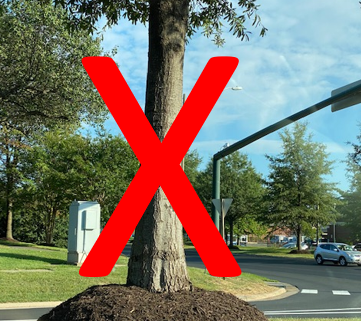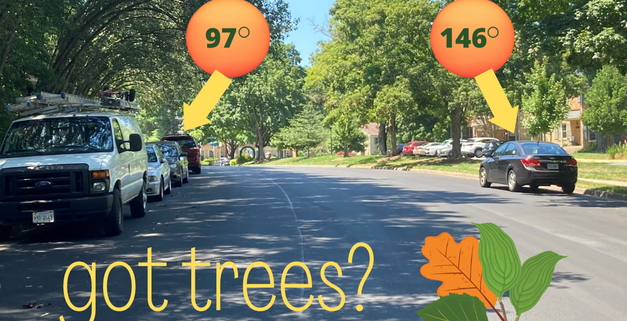Five Myths about Trees
Article and photo (Sara Holtz) by Plant NOVA Natives
It’s no myth that trees hold a special place in our collective psyche. Trees play a prominent role in myths, often symbolizing life and rebirth. Unfortunately, some of the stories about them are just plain wrong.
1. Trees need big piles of mulch. Or perhaps we should call this The Myth of the Angry Volcano Gods, who are appeased by stuffing trees down their maws. It’s hard to know how this harmful practice got started, but we are seeing it everywhere. Trees should be planted with the top of their roots level to the ground, just as in nature. Mulch should never be allowed to touch the trunk, as it causes bark rot. Shredded mulch can form a barrier to water when it mats down, so arborist wood chips are preferred – assuming mulch is needed at all – and no more than 2-4 inches deep. The Fairfax County Tree Basics booklet, which you can download for free, shows proper tree planting and care practices and is available in multiple languages.
2. Tree wounds need dressing. Trees cannot heal the way we do after they are cut, which is one reason why topping a tree is such a bad idea. A broken limb should be trimmed back to just beyond the branch cuff then left alone to try to close over, which with luck it may accomplish before fungi set in. Painting tar on the surface just encourages rot.
3. All leaning trees are dangerous. It is normal for trees to grow toward the light. They reinforce their wood to make themselves stable. If you are worried that a tree may become hazardous, you can get an opinion from a consulting arborist who is certified by the International Society of Arborists (ISA) and who has no financial interest in cutting it down.
4. Trees litter. Well, trees do create leaf “litter”, but that’s an unfriendly word to use to describe feeding the soil and providing habitat for fireflies and wintering grounds for butterflies. The best thing you can do for a tree and the ecosystem is leave the leaves underneath where they fall. If you are afraid they will smother the grass, you can chop them up with a lawn mower so they at least add organic matter to the soil, a practice that is good for the trees and the grass (but hard on the critters).
5. One tree is as good as another. Not so! All trees can provide shade and capture stormwater, but only native trees support biodiversity. In fact, native trees are the very backbone of our local ecosystem, providing the majority of the leaves upon which our native caterpillars feed, which in turn provide the diet required by baby songbirds. In fact, not only do some non-native trees do nothing to feed the birds, they are actually invasive, taking over and destroying what is left of our remnant woods and starting to threaten our bigger forests as well. With few exceptions, there are native trees to serve any landscaping need. Find out all about them on the Plant NOVA Trees website.



